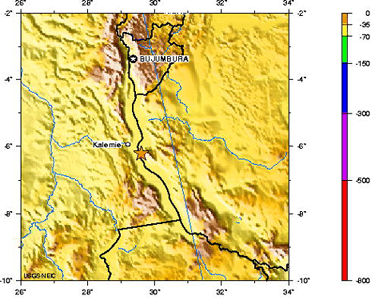Geotimes

Untitled Document

Web Extra
Monday, December 5, 2005, 2:00 p.m. Updated
at 11:00 a.m., Dec. 6
Earthquake shakes East Africa
 A strong earthquake
shook the Lake Tanganyika region in Africa Monday, followed by two small aftershocks
overnight. The magnitude-6.8 earthquake struck at 2:19 p.m. local time and was
centered about 150 kilometers south of Kigoma, Tanzania, according to the U.S.
Geological Survey (USGS).
A strong earthquake
shook the Lake Tanganyika region in Africa Monday, followed by two small aftershocks
overnight. The magnitude-6.8 earthquake struck at 2:19 p.m. local time and was
centered about 150 kilometers south of Kigoma, Tanzania, according to the U.S.
Geological Survey (USGS).
The star denotes the
location of the earthquake that struck the Lake Tanganyika region of Africa
Monday. The star's orange color represents a shallow depth of only 10 kilometers
belowground. Image courtesy of the U.S. Geological Survey.
The earthquake resulted in at least three deaths, a Congo official said in a
Dec. 6 Associated Press report, and a U.N. official announced
that the death toll could continue to rise as reports of casualties and damages
slowly come in. Hard hit in the event were poorly constructed houses in Kalemie,
in the eastern Democratic Republic of Congo, which collapsed and buried several
children, and two small aftershocks overnight may have caused additional houses
to collapse.
The earthquake occurred at a shallow depth of 10 kilometers and originated
from a fault in the East African Rift Zone, which runs north to south for about
3,000 kilometers, from Ethiopia to Zambezi. This zone, "is one of the most
seismically active parts of Africa," says David Applegate, senior science
advisor for earthquake and geologic hazards for USGS. The rift is an unusual
occurrence in which forces pulling apart the continental plate could potentially
split East Africa from the rest of the continent, according to USGS. The crust
at the rift is stretching beyond its limits causing tension cracks, and magma
rising through these cracks can be a source of additional pressure.
Historically, the region has given rise to numerous earthquakes, including
a magnitude-5.5 earthquake in May 2002. That event shook the Lake Victoria,
Tanzania, region, killing two people and leaving more than 400 families homeless.
Kathryn Hansen
Links:
USGS
report on East Africa's earthquake
Associated
Press report on CNN.com, Dec. 6, 2005.
Seismic
hazard map of Africa
Untitled Document

Back to top
 A strong earthquake
shook the Lake Tanganyika region in Africa Monday, followed by two small aftershocks
overnight. The magnitude-6.8 earthquake struck at 2:19 p.m. local time and was
centered about 150 kilometers south of Kigoma, Tanzania, according to the U.S.
Geological Survey (USGS).
A strong earthquake
shook the Lake Tanganyika region in Africa Monday, followed by two small aftershocks
overnight. The magnitude-6.8 earthquake struck at 2:19 p.m. local time and was
centered about 150 kilometers south of Kigoma, Tanzania, according to the U.S.
Geological Survey (USGS). 
